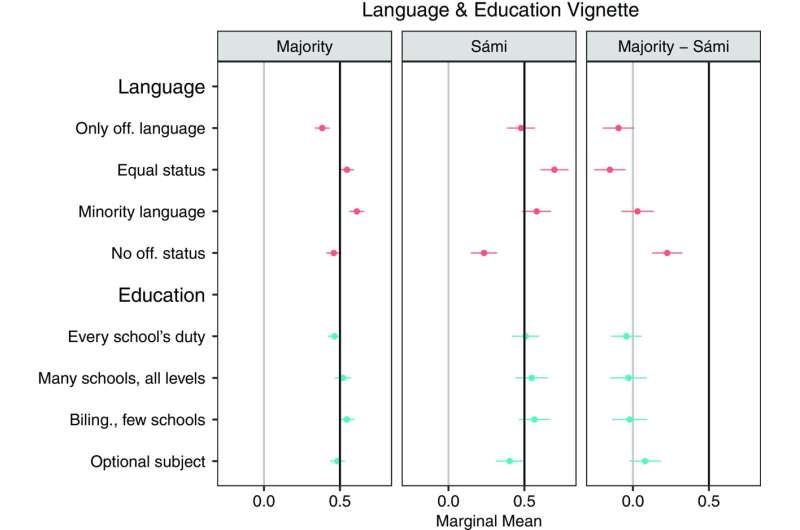How preferences for Indigenous policies differ between the Indigenous and majority populations in Norway and Sweden
On the international level, there is broad consensus that it is essential to recognize and implement Indigenous rights as well as to correct inequalities and historical injustices. Yet many nation-states struggle with effective implementation.
“National policies play a decisive role in the implementation of these rights. At the same time, such policies also clearly depend on public opinion,” explains Fabian Bergmann, a doctoral researcher in the Cluster of Excellence “The Politics of Inequality” at the University of Konstanz.
Study in Norway and Sweden
In a recent study, Bergmann compared the political preferences of the Sámi, an Indigenous population in Norway and Sweden, with those of the majority population in both countries. He studied the level of support for political measures that grant the Sámi rights in the areas of language, self-administration and land use.
The findings are published in The Journal of Race, Ethnicity, and Politics.
The results paint a differentiated picture: On the one hand, Sámi respondents strongly support political agendas that clearly promote the self-determination of the Indigenous population. On the other hand, respondents from the majority population are skeptical of such agendas, but do not completely reject the implementation of Indigenous rights. Instead, the majority population prefers policy measures that allow for limited implementation of Indigenous rights for the Sámi.
Although Sweden and Norway have different national policies on Sámi rights, the attitudes of the majority populations in both countries are surprisingly similar. This suggests that a country’s political context is not the only deciding factor in the formation of these preferences, but that social identity also plays an important role.
Public opinion on Indigenous peoples’ policies is of great relevance for democratic societies. “It is difficult to pursue effective policies for implementing indigenous rights if there is not enough support from the majority population for doing so,” Bergmann says.
Individual rights vs. collective rights
Against the backdrop of Norway and Sweden’s reputation as committed advocates of human rights, he concludes, “The majority of the Swedish and Norwegian population supports international human rights conventions. Yet these conventions only define individual rights, whereas the rights of Indigenous peoples are collective rights.”
“In order to generate a similar level of support among the majority population for both the collective protection of Indigenous peoples and individual human rights, a great deal of persuasion still seems to be necessary.”
More information:
Fabian Bergmann, Divided Attitudes Toward Rectifying Injustice: How Preferences for Indigenous Policies Differ Between the Indigenous and Majority Populations of Norway and Sweden, The Journal of Race, Ethnicity, and Politics (2024). DOI: 10.1017/rep.2023.38
Citation:
How preferences for Indigenous policies differ between the Indigenous and majority populations in Norway and Sweden (2024, February 1)
retrieved 1 February 2024
from https://phys.org/news/2024-02-indigenous-policies-differ-majority-populations.html
This document is subject to copyright. Apart from any fair dealing for the purpose of private study or research, no
part may be reproduced without the written permission. The content is provided for information purposes only.

On the international level, there is broad consensus that it is essential to recognize and implement Indigenous rights as well as to correct inequalities and historical injustices. Yet many nation-states struggle with effective implementation.
“National policies play a decisive role in the implementation of these rights. At the same time, such policies also clearly depend on public opinion,” explains Fabian Bergmann, a doctoral researcher in the Cluster of Excellence “The Politics of Inequality” at the University of Konstanz.
Study in Norway and Sweden
In a recent study, Bergmann compared the political preferences of the Sámi, an Indigenous population in Norway and Sweden, with those of the majority population in both countries. He studied the level of support for political measures that grant the Sámi rights in the areas of language, self-administration and land use.
The findings are published in The Journal of Race, Ethnicity, and Politics.
The results paint a differentiated picture: On the one hand, Sámi respondents strongly support political agendas that clearly promote the self-determination of the Indigenous population. On the other hand, respondents from the majority population are skeptical of such agendas, but do not completely reject the implementation of Indigenous rights. Instead, the majority population prefers policy measures that allow for limited implementation of Indigenous rights for the Sámi.
Although Sweden and Norway have different national policies on Sámi rights, the attitudes of the majority populations in both countries are surprisingly similar. This suggests that a country’s political context is not the only deciding factor in the formation of these preferences, but that social identity also plays an important role.
Public opinion on Indigenous peoples’ policies is of great relevance for democratic societies. “It is difficult to pursue effective policies for implementing indigenous rights if there is not enough support from the majority population for doing so,” Bergmann says.
Individual rights vs. collective rights
Against the backdrop of Norway and Sweden’s reputation as committed advocates of human rights, he concludes, “The majority of the Swedish and Norwegian population supports international human rights conventions. Yet these conventions only define individual rights, whereas the rights of Indigenous peoples are collective rights.”
“In order to generate a similar level of support among the majority population for both the collective protection of Indigenous peoples and individual human rights, a great deal of persuasion still seems to be necessary.”
More information:
Fabian Bergmann, Divided Attitudes Toward Rectifying Injustice: How Preferences for Indigenous Policies Differ Between the Indigenous and Majority Populations of Norway and Sweden, The Journal of Race, Ethnicity, and Politics (2024). DOI: 10.1017/rep.2023.38
Citation:
How preferences for Indigenous policies differ between the Indigenous and majority populations in Norway and Sweden (2024, February 1)
retrieved 1 February 2024
from https://phys.org/news/2024-02-indigenous-policies-differ-majority-populations.html
This document is subject to copyright. Apart from any fair dealing for the purpose of private study or research, no
part may be reproduced without the written permission. The content is provided for information purposes only.
